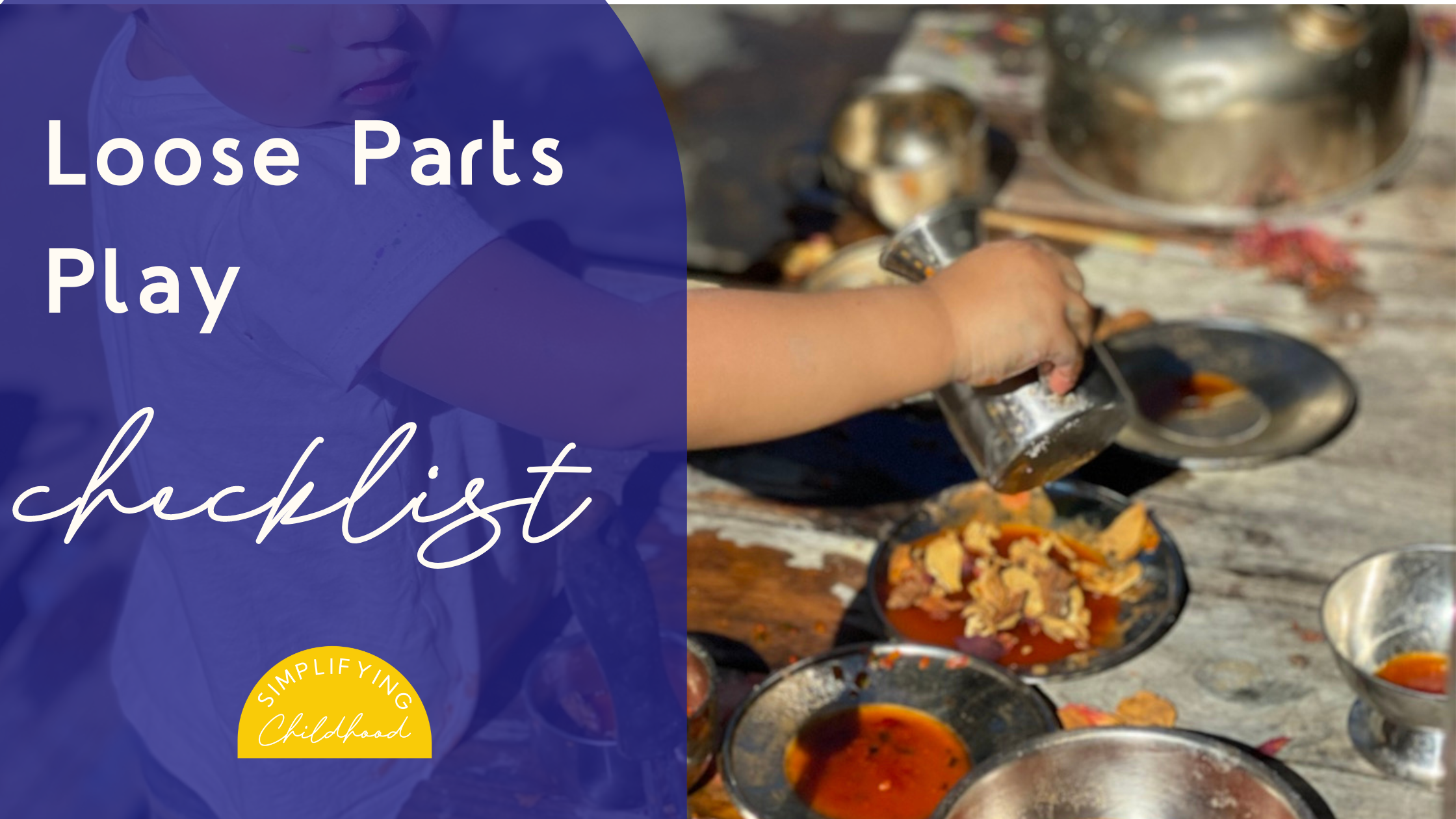Loose Parts Play Checklist
What are Loose Parts?
When it comes to play, children have a remarkable ability to find joy and amusement in the simplest of things. It can be disheartening to witness your child ignore their expensive toys in favor of a cardboard box or a sheet of wrapping paper. But perhaps there is something we can learn from these situations.
Consider the times when you've watched children engrossed in play with dirt, leaves, or sand. There is an innate sense of wonder and curiosity that emerges when they are engaged with these natural loose parts. Their imagination takes flight as they sculpt mud pies, build sandcastles, or create leaf collages. In these moments, they are not limited by predetermined outcomes or restricted by a set of instructions. They are free to explore, experiment, and create something entirely unique.
The concept of loose parts, as coined by Simon Nicholson in the 1970s, recognizes the power of open-ended materials in fostering creativity and exploration. These materials can be anything from natural elements like rocks and sticks to recycled items like bottle caps and fabric scraps, or even synthetic materials like pom-poms and beads. The beauty of loose parts lies in their versatility and adaptability. They can be used individually or combined to create endless possibilities.
Unlike some pre-packaged toys with a specific purpose, loose parts invite children to think critically and problem-solve. They provide opportunities for sensory experiences, fine motor development, and imaginative play. By incorporating loose parts into the learning environment, you are giving them the freedom to shape their own play experiences and discover the boundless potential of their creativity.
Loose Parts Benefits
There are a range of benefits of incorporating loose parts into children's play. One key aspect that stands out is the unlimited creativity and open-endedness that these loose parts provide. Research has shown that loose parts play offers not only physical benefits but also social and creative advantages.
One organization that delves into the benefits of loose parts play is Nature Play SA. They emphasize the portability of loose parts, which allows children the freedom to play anywhere and everywhere.
The beauty of these open-ended materials is that children can utilize them in ways that suit their own interests, abilities, and developmental stage. This versatility prompts children to think creatively and critically, as they experiment with various ways to interact and manipulate the loose parts. Such activities contribute to their cognitive and problem-solving skills.
It is crucial to prioritize the inclusion of loose parts in play environments. By doing so, we provide children with the opportunity to experience the physical, social, and creative advantages that these materials offer. Through loose parts play, children can thrive, grow, and discover their potential in a holistic and enjoyable manner.
Problem Solving
Engineering
Creativity
Concentration
Hand-eye coordination
Fine motor development
Gross motor development
Language and vocabulary building
Mathematical thinking
Scientific thinking
Literacy
Social/emotional development
Loose Part Play Material Ideas
The best part about loose parts is that they are readily available. Take a look around, and you'll find a treasure trove of potential loose parts hiding in plain sight. Plastic containers, pots, pans, cardboard tubes, fabric scraps - these everyday items can become the building blocks of imagination. There is no need to go out and buy expensive toys when you already have a wealth of loose parts waiting to be repurposed.
For ease, I have broken up loose parts into a number of categories, and some items may fit a cross in one or two areas. But the idea here is to have a range from each category in your loose parts space. No material is more desirable or valuable with loose parts.
Nature-Based Loose Parts
Nature provides a rich and diverse array of materials that can inspire endless creative play for children. From the crunch of leaves under their feet to the soothing sounds of a babbling brook, here are some nature-based loose parts that can ignite a child's imagination:
leaves
seed pods
shells
bark
sticks and twigs
rocks
Recycled Loose Parts
Using recycled materials adds an eco-friendly twist to loose parts play. From cardboard tubes to plastic containers, these repurposed materials offer endless possibilities for open-ended play and exploration.
bottle lids
cardboard cups
cotton reels
containers
egg cartons
fabric scraps or scarfs
beads
buttons
baskets and trays
kitchen utensils
pots, pans, baking trays
ice cube trays
Loose Part Toys
Just because something is a ‘toy’ does not mean it is not considered or could not be used as a loose part. Focus here on open ended materials and rethink how your current toys can be used. Some loose parts toys to consider:
blocks
lego
wooden mandala pieces
magnetic tiles
Bigger and outdoor loose parts
Looking to go large or take loose parts outside? Consider incorporating items such as logs, tree stumps, and hollowed-out tree trunks, which can serve as versatile building blocks, balance beams, and even cozy hideouts in a natural play environment. For an added touch, you can also explore incorporating recycled tires, which can be transformed into obstacle courses, seating areas, or imaginative vehicles for children to zoom around in. Other materials to consider:"
crates
ropes
tarps
pallets
climbing frames
Planning for loose parts play
To ensure a successful loose parts playtime, it's helpful to create a plan before starting to audit what you already own. So I have created a comprehensive guide and checklist for handy reference when gathering a variety of loose parts and ensuring that children have access to a range of materials.
So, the next time you observe your child immersed in play with a humble box or a handful of pebbles, embrace it. Encourage their exploration with loose parts and witness the magic unfold. Not only will they develop important skills and abilities, but they will also learn the valuable lesson that the joy of play often lies in the simplest of things.












